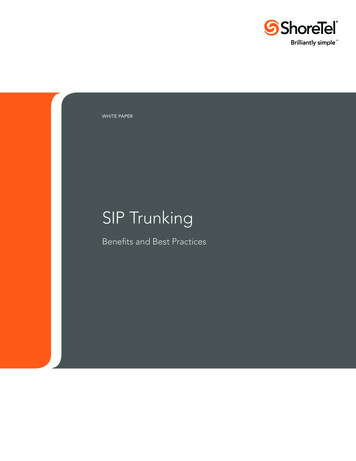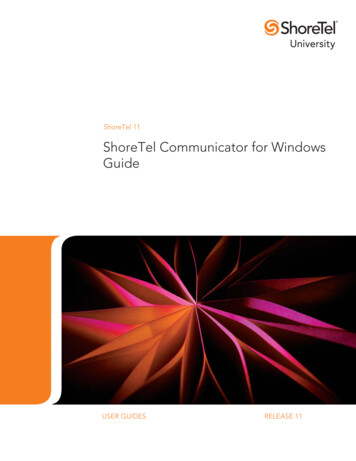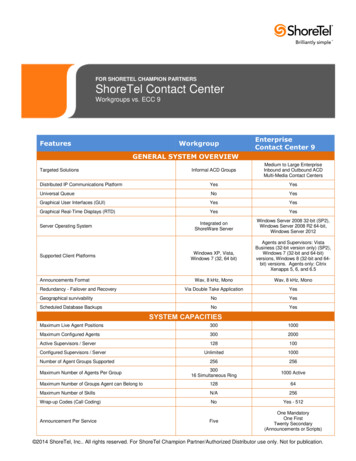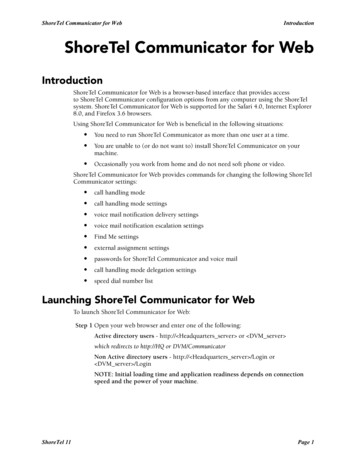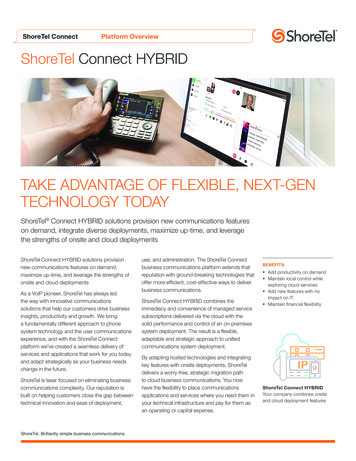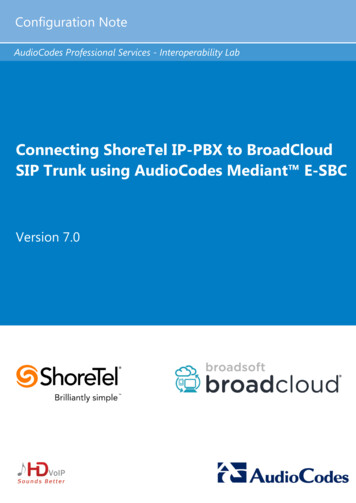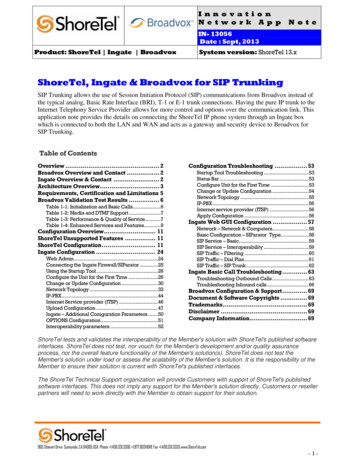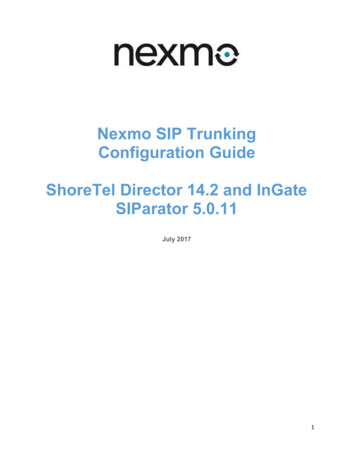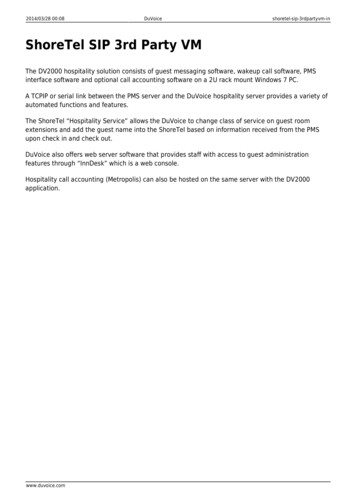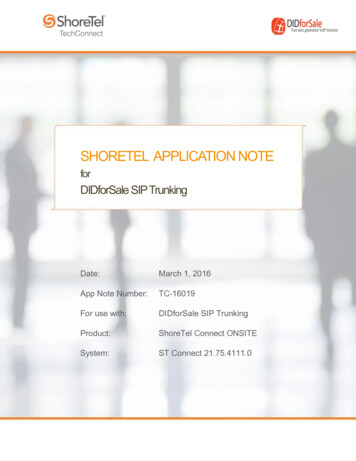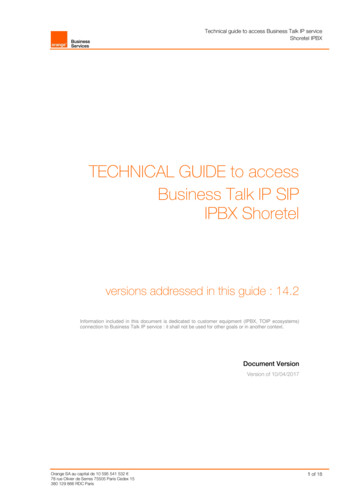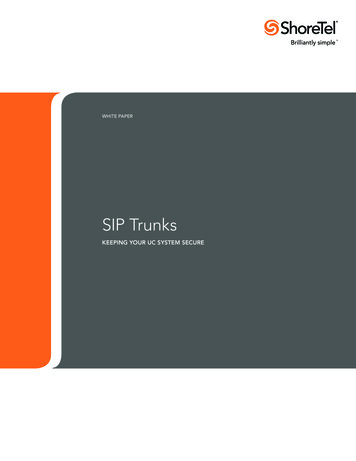
Transcription
WHITE PAPERSIP TrunksKeeping your UC System Secure
Table of Contents1.Executive summary . . . . . . . . . . . . . . . . . . . . . . . . . . . . . . . . . . . . . . . . . . . . . . . . . . 32.Security considerations for SIP trunks . . . . . . . . . . . . . . . . . . . . . . . . . . . . . . . . . . . . 52.1. Threats . . . . . . . . . . . . . . . . . . . . . . . . . . . . . . . . . . . . . . . . . . . . . . . . . . . . . . . . . 52.2. Importance of stable platform. . . . . . . . . . . . . . . . . . . . . . . . . . . . . . . . . . . . . . . . 53.SIP, NATs and Enterprise Firewalls . . . . . . . . . . . . . . . . . . . . . . . . . . . . . . . . . . . . . . 64.Methods for solving NAT/firewall traversal if SIP. . . . . . . . . . . . . . . . . . . . . . . . . . . 74.1. SIP-capable firewalls . . . . . . . . . . . . . . . . . . . . . . . . . . . . . . . . . . . . . . . . . . . . . . . 74.2. Enterprise session border controllers . . . . . . . . . . . . . . . . . . . . . . . . . . . . . . . . . . 94.3 Session border controllers at the service provider edge. . . . . . . . . . . . . . . . . . . 105.SIP proxy-based firewalls and enterpriseSBCs:security advantages of the SIP proxy. . . . . . . . . . . . . . . . . . . . . . . . . . . . . . . . . . . . 115.1. Controlling media . . . . . . . . . . . . . . . . . . . . . . . . . . . . . . . . . . . . . . . . . . . . . . . . 115.2 SIP signaling. . . . . . . . . . . . . . . . . . . . . . . . . . . . . . . . . . . . . . . . . . . . . . . . . . . . . 126.Which NAT/firewall traversal solution is right for you?. . . . . . . . . . . . . . . . . . . . . . 137.Conclusion. . . . . . . . . . . . . . . . . . . . . . . . . . . . . . . . . . . . . . . . . . . . . . . . . . . . . . . . . 15Figure 1.Postioning of NAT traversal solutions . . . . . . . . . . . . . . . . . . . . . . . . . . . . . . 3Figure 2.TBD . . . . . . . . . . . . . . . . . . . . . . . . . . . . . . . . . . . . . . . . . . . . . . . . . . . . . . . . . 7Figure 3.B2BUA functionality . . . . . . . . . . . . . . . . . . . . . . . . . . . . . . . . . . . . . . . . . . . . 9Figure 4.Session Border Controller at the Service Provider . . . . . . . . . . . . . . . . . . . 10Figure 5.Positioning of NAT traversal solutions . . . . . . . . . . . . . . . . . . . . . . . . . . . . . 13Figure 6.Security and Flexibility. . . . . . . . . . . . . . . . . . . . . . . . . . . . . . . . . . . . . . . . . . 14SIP Trunks - Keeping your UC System SecurePAGE 2
1. introductionThe appeal of Session Initiation Protocol (SIP) trunks as a means of connecting UCsystems to the outside world is growing in popularity. SIP trunks offer lower operatingcosts, more flexibility in ordering service and capacities and advanced features, such asvirtual phone numbers in different geographies, which let companies establish a virtualworldwide presence.In contrast to legacy PRI trunks, SIP trunks use IP-based protocols that require a system tobe opened up to a wide area network (WAN) that should be assumed insecure.Customers must educate themselves about the salient security aspects pertaining to SIPtrunks and how to ensure the appropriate level of security.SIP was developed by the Internet Engineering Task Force (IETF) and has become aleading signaling protocol for establishing real-time communications, including voiceover-IP (VoIP) calls.However, SIP-based communication originating from outside the enterprise does notautomatically reach users on the local area network (LAN) as it has to traverse firewallsand/or routers that perform Network Address Translation (NAT). Firewalls are designedto prevent inbound communications from unknown sources and the NAT feature gets inthe way of proper addressing of users and devices on the LAN.The choice of method for traversing firewalls/NATs is, to a large extent, dependent onthe answer to the question: “Who should be in control of your SIP trunk security: theenterprise firewall administrator or the service provider?”SOHOSMBSession BorderControllers (SBC)at ITSPLowEnterprisesSIP CapableFirewalls &EnterpriseSBCsHighCustomers’ need for keeping control of security infrastructureFigure 1 - Positioning of NAT traversal solutionsSIP Trunks - Keeping your UC System SecurePAGE 3
Session Border Controllers at Service Provider: The service provider is in controlMost service providers use some sort of session border controller (SBC) in their corenetwork to perform a number of tasks related to their SIP services. One of these tasksis to make sure that the SIP services can be delivered to their customers. They may useprotocols like STUN, TURN or ICE for this by acting as a server component for theseprotocols. However, not all clients support these protocols so the SBC may also usefar-end-NAT traversal (FENT) technology for NAT traversal. This solution only works withfirewalls that are open from the inside, and may not work with all equipment and in all callscenarios. FENT also removes control from the firewall, which must be sufficiently open toallow FENT from the service provider SBC to work.SIP-capable Firewalls or enterprise SBC: The firewall administrator is in controlThis option solves the problem where it occurs: at the firewall or in tandem with anexisting firewall using an enterprise SBC. When deployed at the enterprise edge, the SBCoffers the same security and control as it does for the service provider’s core network.The enterprise SBC typically has a built-in SIP proxy and/or back-to-back user agent(B2BUA) functionality to give unparalleled flexibility for enterprise deployments.There are special security and functional requirements that make a SIP-capable firewallor enterprise SBC the solution of choice. Firstly, this is the only solution that allowsthe firewall to maintain control of what traffic can traversed between the LAN and theoutside world. Secondly, such an SBC or firewall is fully SIP aware and can act as thebridge between SIP implementations that differ slightly between vendors, a commonphenomenon that is seen despite SIP maturing as a standard.Most vendors of SBCs for service providers have products that can be deployed at theenterprise edge. ShoreTel resells the Ingate SIParator enterprise SBC that performs theabovementioned functions.SIP Trunks - Keeping your UC System SecurePAGE 4
2. Security considerations for SIP trunks2.1 ThreatsConnecting any device to the Internet or WAN can expose the entire network to manytypes of threats. One example is a brute force attack where the intruder tries to log into aservice using a user/password database with a huge number of username and passwordcombinations. The intruder tries each until finally succeeding in finding the right one.Once access has been granted the intruder may be able to launch other types of attacksbased on known vulnerabilities to the service in question and in this way get access toother services or data.Another example of a threat would be denial of service (DoS) attacks where the attackeruses many different hosts or “bots” to send a large number of packets to overwhelm thehost, causing it to go down.The above are two examples of traditional data communication attacks. These and manyothers can easily be leveraged into attacks on UC or IPBX systems.2.2 Importance of a stable platformFirewall vendors have developed significant expertise in securing data communication.They know how to implement stable systems that are locked down to only admit servicesthat have been configured to pass through. Firewalls inspect and log traffic and they caneven block suspected attacks including traffic from known bad sources.Firewalls alone cannot prevent DoS attacks, but they can be hardened to withstandattacks, making them more resilient. More importantly, they can be built to protect theenterprise LAN from the DoS attack itself. A good enterprise SBC should have the samestability and resiliency—essentially a firewall “specialized in VoIP.”SIP Trunks - Keeping your UC System SecurePAGE 5
3 SIP, NATs and Enterprise FirewallsThe market for SIP-based real-time communications is expected to grow significantlygoing forward.Today’s SIP implementations are both robust and feature rich. However, SIP-basedcommunications cannot reach LAN users behind firewalls and NATs automatically,because firewalls are designed to prevent inbound unknown communications. NAT hidesthe private IP addresses on the LAN, stopping users on the LAN from being addressedfrom the outside. Very few, if any, communications are received directly from outsidethe LAN, so only authorized users can gain access to our networks and the valuableinformation stored on our local servers and computers.The NAT that is created on the firewall or by routers is also a part of the security fabric.NATs are necessary primarily because the Internet IPv4 standard does not supportenough unique IP addresses to allow all of the devices connected to the Internet to havetheir own identity through a unique IP address. With NAT, only the firewall or router isgiven a publicly routable IP address. Each device is then assigned a private IP addressthat is only known inside the firewall-protected space. While this works fine for the typesof traffic that are typically supported on the LAN, it prevents inbound communicationsfrom reaching the intended recipient behind the firewall because the IP address of theclient device is unknown and not routable.Finally, most firewalls do not support the SIP protocol. As with all other protocol types,the firewall must recognize the format of the signaling in order to admit it to the network.Since many firewalls installed today do not support SIP, the inbound traffic will bestopped for this reason alone.So why is this important?There are a number of available methods for firewall traversal. Each has its own benefits,but many have significant drawbacks. These drawbacks impact security. The choice ofmethod for traversing firewalls/NATs determines the amount of control and security youmaintain of your network. Is your security best left to your firewall administrator? Your ITSP? Also, does the solution need to work with all ITSPs, or only one specifically? How SIP-compliant does it really need to be? Will SIP interoperability issues affect security?The answers can help determine which method of firewall/NAT traversal is right for yournetwork.SIP Trunks - Keeping your UC System SecurePAGE 6
The choice of traversal method also has an impact on the future-proofing of yournetwork. The use of SIP is expanding from SIP trunking (voice) to video and beyond.When SIP is widely deployed, interaction becomes more collaborative, with partners,vendors, employees and even customers using the most effective tool for every occasion,whether that be instant messaging, presence, voice, video, application sharing, whiteboarding or file sharing.Investing in the appropriate solution allows the enterprise to grow with the expandingrole of SIP.4. Methods for solving NAT/firewall traversal of SIPEventually, all firewalls will need to be SIP capable in order to support the wide-scaledeployment of SIP trunks and SIP based real-time communications. In the interim, severalsolutions are available to work around the firewall/NAT traversal issues that limit SIPbased communication.4.1 SIP-capable firewallsThis is a long-term solution where the problem is solved where it occurs, at the enterprisefirewall or in tandem with the firewall using an enterprise session border controller.Figure 2SIP Trunks - Keeping your UC System SecurePAGE 7
4.1.1 SIP ALG-based SIP-capable firewallsThe majority of all SIP-capable firewalls today use the SIP Application Level Gateway(ALG) architecture. This works for basic call scenarios but has limited functionalityfor real deployments of enterprise SIP-based real-time communications. The SIP ALGarchitecture tries to solve the firewall traversal problem of SIP traffic by “taking care ofthe SIP packets on the fly,” making sure that they reach the right destination on the LAN.This architecture does not provide the enterprise with the full protection and flexiblefunctionality of a SIP proxy-based firewall solution.4.1.2 SIP proxy-based SIP-capable firewallsThe SIP proxy architecture is a complete solution to the firewall and NAT traversal issuespresented by the enterprise firewall. A proxy is designed to briefly stop the packets sothat each signaling packet can be inspected before the header information is rewrittenand the packets are delivered to the appropriate endpoints. This provides the enterprisewith a flexible, controlled implementation of SIP-based communications.In addition, the SIP proxy can offer benefits not available with the ALG architecture. Far-end NAT traversal to support remote workers such as road warriors and home users Encrypted SIP signaling (TLS) and media (SRTP) Authentication Advanced filtering Advanced routing and control features Intelligence to enable the firewall to act as a backup for a hosted or centralized IP-PBXTo gain unparalleled flexibility, some SIP proxy solutions, including the one fromShoreTel and Ingate, also embed a so-called back-to-back-user-agent (B2BUA)functionality. The B2BUA allows the firewall to have two different call legs in the samesession, one on each side of the firewall. This can help if for example the ITSP does notsupport call transfers with the SIP method REFER. The firewall can then utilize “local calltransfer” by just changing the call leg on the LAN side from one client to the other.SIP Trunks - Keeping your UC System SecurePAGE 8
Figure 3 - B2BUA functionality4.2. Enterprise session border controllersMany enterprise customers are reluctant to replace their existing firewalls with newSIP-capable firewalls because they have spent a great deal of effort setting up securitypolicies. Yet enterprises must overcome the limitations of their existing firewalls,whether they have firewalls with no SIP functionality or SIP ALG firewalls with limited SIPfunctionality.This need has triggered the development of a new type of product which some peoplecall the “enterprise session border controller.” The Ingate SIParator as offered byShoreTel is an example of such a device designed to work in networks where a corporatefirewall is already in place. The SIParator can be considered a firewall just for SIP trafficwhich can be installed either in a standalone configuration, or as part of the DMZ of theexisting firewall. Essentially the SIParator assumes control of SIP traffic without involvingthe existing firewall in the process.SIP Trunks - Keeping your UC System SecurePAGE 9
4.3. Session border controllers at the service provider edgeMost service providers use some sort of SBC in their core network to perform a numberof tasks related to their SIP services. One of these tasks is to make sure that the SIPservices can be delivered to their customers.The SBC at the service provider may use a far-end NAT traversal (FENT) technology forNAT traversal. Typically, FENT is implemented by continuously sending dummy packetsthrough the firewall to keep pinholes open for the media to cross, or by asking the clientto re-register in short intervals to keep those ports available.Figure 4 - Session Border Controller at the Service ProviderSIP Trunks - Keeping your UC System SecurePAGE 10
5. SIP proxy-base firewalls and enterprise SBCs: security advantages ofthe SIP proxy5.1 Controlling mediaSIP proxy technology is an excellent way to add a level of control to the flow of SIP media.This control offers tremendous advantages with regard to security.The main purpose of SIP is to set up a media session between clients. Media is handledby other protocols (often RTP). For media to traverse the enterprise edge, the SIP proxymust dynamically open the media ports for media to flow during the duration of the call.As soon as the call is completed the media ports are closed. This behavior is much moresecure than solutions with non–SIP-aware firewalls/border elements where a media portrange constantly needs to be open. In general the SIP proxy approach is more securethan the IETF specified STUN/TURN/ICE methods, which requires that ports are leftopen from the inside of the firewall to allow media port negotiation to succeed.In addition to the dynamic opening and closing of media ports, the edge device shouldonly accept incoming media from the endpoint that receives media from the edgedevice. This protects against hackers trying to inject media from other endpoints ordevices.To protect media from being overheard by unauthorized persons, media encryptioncomes into play. The industry has chosen SRTP using descriptions for key exchange asthe de facto standard for media encryption. Using SRTP to encrypt media traversing theInternet effectively stops eavesdropping. The integrity of the call is much stronger thanever possible on PSTN.SIP Trunks - Keeping your UC System SecurePAGE 11
5.2. SIP signalingFirewalls with a SIP server and full SIP proxy play a critical role in maintaining enterprisesecurity, and securing VoIP. They can rewrite SIP signaling and process in a very flexibleway, ensuring correct routing and interoperability with other systems built to RFC 3261and related standards.One important part of the SIP proxy is the SIP parser. The SIP parser verifies that theSIP message is valid and that it may be forwarded to the local LAN. Malformed SIPmessages are discarded. The SIP parser must be robust enough to withstand any typesof malformed SIP messages without crashing. Also, to mitigate DoS attacks, the parsershould be able to process a very large number of packets.The SIP proxy should include support for the optional loop detection mechanism definedin the SIP specification. This mechanism discerns whether a SIP message is looping(sending the SIP message to itself) and, if so, aborts this behavior. This detectionmechanism also protects against DoS attacks where a SIP message is constructed tocreate loops and thus keep the SIP proxy too busy to engage in useful processing.To protect resources, e.g. a PSTN gateway, authentication of SIP users should besupported. The standard means of authentication of SIP users is via the digest protocol.SIP users’ credentials should be stored in a centralized database e.g. on a RADIUS server.This is more secure and likely easier to maintain.SIP signaling consists of messages in ASCII text (plain text), and is therefore easy to readand manipulate. It is strongly recommended to encrypt and authenticate SIP signaling.This is normally achieved by supporting TLS or MTLS. MTLS is the most secure methodas both server and client mutually authenticate each other using CA-signed certificatesor certificate chains.To provide greater and more flexible protection mechanisms, filters are useful features. Atypical filter would include the following features: SIP methods can be allowed or prohibited per network. Authentication can be enabled or disabled per network and SIP method. SIP messages can be filtered on content type. Incoming callers can be restricted to a white list; this list can be individually enabled/disabled per user. A filter based on from/to header can be used to allow or disallow processing.SIP Trunks - Keeping your UC System SecurePAGE 12
6. Which nAt/firewall traversal solution is right for you?The choice of method for traversing firewalls/NATs is, to a large extent, dependent onthe answer to the questions: Who should be in control of your security infrastructure: the firewall administrator or aservice provider? Do we want a solution that is predictable and functions reliably with SIP standardcompliant equipment or is it sufficient with a best effort solution that works in certainscenarios and maybe only with a specific operator?SOHOSMBSession BorderControllers (SBC)at ITSPEnterprisesSIP CapableFirewalls &EnterpriseSBCsLowHighCustomers’ need for keeping control of security infrastructureFigure 5 - Positioning
The appeal of Session Initiation Protocol (SIP) trunks as a means of connecting UC systems to the outside world is growing in popularity. SIP trunks offer lower operating . ShoreTel and Ingate, also embed a so-called back-to-back-user-agent (B2BUA) functionality. The B2BUA allows
